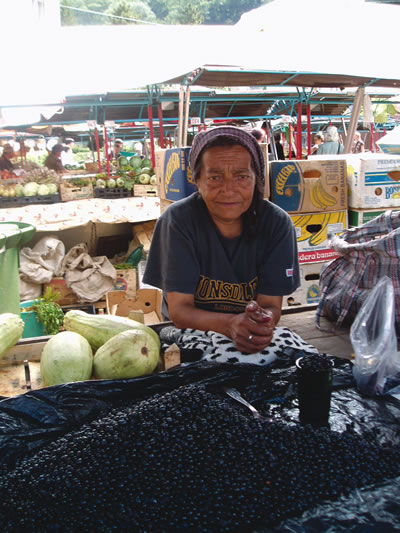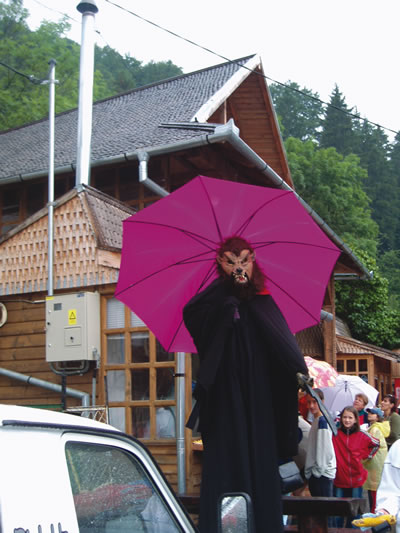Volunteering in Transylvania
Combine Service with Cultural Immersion in a Legendary Region of Romania
Article & Photos by Joanna Liss

|
|
The blueberry seller in Transylvania.
|
One recent summer, when my kids went to their New England summer camps, I went to camp, too. In Transylvania! My program was a 2-week volunteer camp, one of several thousand possibilities available through Volunteers for Peace, a Vermont-based organization. VFP is a part of an international network that offers short-term volunteer opportunities in over 100 countries.
There are programs involving renovation, teaching, working in summer camps, social service organizations, festivals, and more. The cost of participation is the $250 application fee to VFP, the volunteer’s travel costs to the location, and sometimes a small additional fee to the sponsoring organization for the cost of meals and accommodation.
My volunteer experience in Romania is one of four stints I’ve done through VFP over the last few years. The others were in rural Thailand, a Peruvian mountain town, and Paris. Each has been a wonderful experience, and I have traveled on my own before or after each one, as well as on some weekends when we were not working.
My Transylvanian placement involved working with children in a social service center called Everychild, in Cluj-Napoca. Cluj is a pleasant city with an historic past and a large student population.
Our accommodations were at a university dorm in the center of town. My fellow volunteers hailed from seven countries. The volunteers were primarily in their twenties and thirties. I, at 53, was the second oldest. Two were young Italian adults with Down Syndrome, (participation by people with disabilities is encouraged) accompanied by their chaperone.
The kids at Everychild ranged from eight to about 15. We went each morning to a nearby park. Afternoons were spent in clubs we’d organized, mime and juggling, drumming and dance. Our drumming team included Geanina, Caroline, Rubin, and Amy from Romania, France, Holland, and Britain. We collected cardboard boxes and wooden crates, water bottles filled with rice and beans, the trash cans from our dorm rooms, and with the kids improvised rhythms for an hour every day. Eventually, our pounding solidified into the distinctive rhythm of “We Will Rock You.” Music is truly an international language.
Most nights we cooked for ourselves, in two-person teams, using the small budget allotted. One night we ate at a traditional restaurant. I sampled stuffed cabbage a la Cluj, polenta heaped with cheese and cream, and tuica, the traditional and extremely potent plum brandy.
One weekend, eager to experience local culture, I visited a small village with Mina, a Czech volunteer. My Rough Guide called Sic the “musical village” and described it as having a band on virtually every corner, and a wedding most every weekend.
We set off by train to Gherla, followed by a mini bus to Sic. Mina and I were the only passengers, aside from the driver’s wife. Upon our arrival, she announced “Sic” and eyed us quizzically. I said “musica?” Mina, in a creative effort at communication, whistled “Here Comes the Bride.” They looked more puzzled, drove up to their home, and invited us in. We stayed there that night, in a house filled with traditional embroidered pillows, blankets, painted benches, ceramic plates, all decorated a bright red.
The couple’s 9-year-old son spoke a bit of English. Mr. Sukosd could not speak at all. It seemed that his voice box had been removed. His wife was garrulous, if miming can be described as such! She cooked us supper and breakfast, and charged us $5 each. We each had our own red bedroom. When she offered us each one of her own nightgowns to wear to bed, I couldn’t say no, even though I had brought my own. It was an experience no amount of money could have bought.
In the afternoon, walking through the village, we met an elderly woman carrying a bagful of traditional clothing for sale. Veronica brought us to her tiny home with a woodstove and no indoor plumbing. She was tiny, too, and I felt as though I’d wandered into a fairy tale from Grimm. We spent over an hour trying on clothing, much to Veronica’s delight. She served us delicious soup cooked on the woodstove, and we purchased skirts, blouses, and two leather embroidered vests.
But we never found any music until, as we waited to board the bus back, three gypsy men walked silently up the road in a single line, each with a violin tucked under his arm. I longed to know where they were going, and was tempted to follow them, but didn’t know when there would be another bus back. Besides, Mina had purchased a half watermelon from the vendor in the square, and I couldn’t imagine her carrying it back to our dorm alone.
Despite the lack of music, Sic was a highlight of my Transylvanian adventure, a serendipitous delight. I can only guess that the Rough Guide writer had happened upon the village during a large wedding celebration. No other guidebook even mentioned Sic.
After our 2-week camp ended, I spent another two weeks in Romania. I began by traveling with one of the Romanian volunteer camp leaders, Anca, to her parents’ home in Moldova. It was an 8-hour train ride from Cluj, to the other side of the country. She knew I was eager for more Romanian culture.
I visited Sigishoara, a charming and friendly medieval town in Transylvania. There was a wonderful crafts fair where I tried my hand at traditionally decorating eggs. The same organization that organized the fair trained local teens to give tours. My 14-year-old guide was knowledgeable, enthusiastic, and clearly proud of his town. My favorite memory was of a three-man band playing to me, their only customer, at an outdoor restaurant. When they paraded into the kitchen, still playing, I followed them to see the two cooks begin dancing with hooked arms while my meal simmered on the stove.
I spent several days in Brasov, the jumping off point for Dracula’s Castle. Many buildings date from medieval times, and many more from the 17th to 19th centuries. Juxtapositions of modern and old abound. My accommodations were again in a private home. My hosts were, like everyone I met in Romania, very welcoming.
I visited the local history museum, the modern mall, and the food market, where I bought a huge bag of blueberries from an elderly seller whose palms were stained a deep purplish blue (as were mine for a day or two afterward). One day I boarded a local bus to Bran Castle in search of Dracula. Although I expected nothing more than a honky-tonk tourist spot, I certainly could not leave Transylvania without a visit to Bran.
The real Dracul, a vicious character known, among other horrors, for impaling his victims’ heads on stakes, was of course in reality no vampire, although there were many vampire tales in Europe in his time. It is to author Bram Stoker that we owe the Count Dracula legend. And Bran itself has little connection to Dracul; he may once have passed through, and perhaps battled nearby. Sighisoara, in fact, has more of a historical connection to Dracul, being the town where he was born.
The castle was more picturesque than imposing, and hardly scary with crowds of tourists at every turn. On the edge of the property is a truly tacky souvenir marketplace with items like plastic swords and glow-in-the-dark skeletons.
I did find Dracula. He was a formidable creature on stilts, dressed in black with a plastic mask. He roamed the market tapping teenage girls on the rear with his plastic saber. And then, Dracula decided he was thirsty. He approached the snack bar, removed his mask, and bent down to order a soda, revealing a sweet-faced boy of perhaps 15.

|
|
Dracula makes an appearance in Transylvania.
|
I had chosen Transylvania partly because I knew so little about it, and because I knew there was much more than Dracula to discover there. My Transylvanian friends were amused to know that most Americans’ entire concept of their country was of the infamous Count. My family and friends at home were equally entertained to hear about where I’d spent my summer vacation. I have been delighted to share with them some of my Transylvanian adventures. And I am now contemplating my next VFP workcamp. Shall it be Turkey? Italy? Estonia? The possibilities are endless.
|
For More Info
Volunteers for Peace list many short-term volunteer opportunities which are called workcamps. Most are of 2-week duration, and it is possible to enroll for multiple camps. Most are offered during the summer, but there are opportunities throughout the year. The listings are published each March, and before that you can view the previous year’s list.
The Continental Hotel in Cluj-Napoca, where I spent my first night, is over a century old, impressive on the exterior, a bit run-down but atmospheric inside. It also served as the local Nazi headquarters during the Second World War. Private rooms include breakfast. There are also inexpensive hostel accommodations in the attic.
To reach Sic, take the train from Cluj to Gherla and ask for directions to the bus depot, about a 10-minute walk. The mini-bus to Sic is run by Ioan Sukosd. He and wife Zsuzsa will make delightful hosts if you decide to spend the night.
If you find Veronica, (she looks like Borat’s “mother” in one of the film’s early scenes) give her a hug for me!
In Brasov, several pleasant rooms are offered by the friendly Beke family. Various other families also rent rooms, and there are a number of hotels. There are bus tours to Bran Castle, or you can take the local bus, as I did.
Transylvania lies midway between Bucharest, the Romanian capital, and Budapest, Hungary. I flew into Budapest and went by train to Cluj. Cluj is also reachable by air or bus from either capital.
|
Joanna Liss has worn many hats professionally. She has managed a children’s bookstore
and toy store, worked for a Japanese exchange organization, and au paired for an international organization.
|
